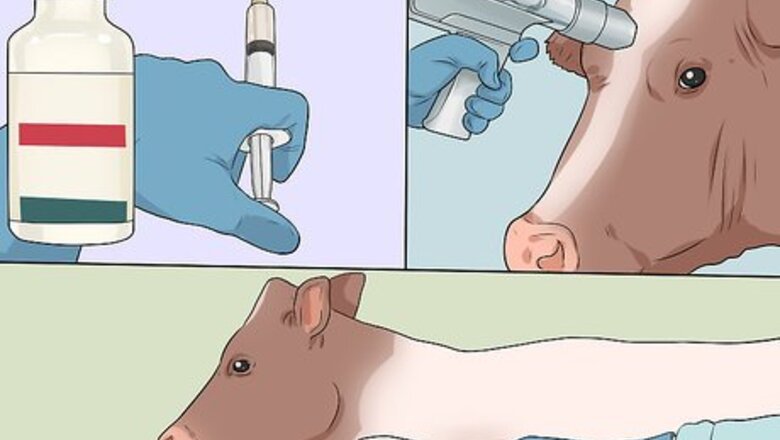
views
X
Research source
" If you have an animal that is suffering from disease or injury that cannot be treated or is irreversible in nature, or have one or more animals to be slaughtered, methods of euthanasia are effective when properly done. When improperly done, animal suffering results.[2]
X
Research source
[3]
X
Research source
If you own or routinely work with cattle, it's important to be prepared and understand the potential need to perform euthanasia. Euthanizing cattle is definitely not something to take lightly. You and others working with you must be armed with the knowledge, necessary skills and properly maintained equipment should a situation arise where emergency euthanasia is necessary. Several criteria, indications, and selection considerations must be realized when making a decision about whether and how to euthanize a cow, and this article will walk you through them. But most importantly, the biggest factor to consider is yourself: If you do not have the skill, technical proficiency, mental capability or knowledge and necessary training needed to properly euthanize an animal, it's highly recommended to have someone with that necessary skill and experience to do the job for you.
Steps
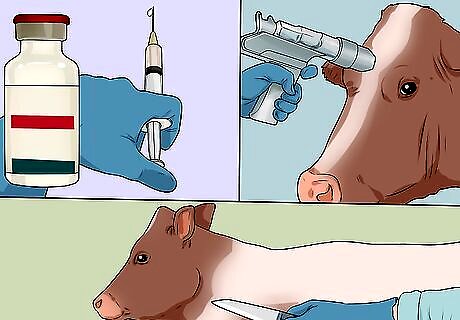
Understand the methods most appropriate for euthanizing cattle. The three primary methods of euthanasia are overdose with barbiturate, penetrating cap-bolt, or gunshot with a firearm. These methods are explained in more detail below. Secondary euthanasia methods to be used after one of the previously mentioned methods is exsanguination, pithing, or a rapid IV injection of potassium chloride or magnesium sulfate. These will also be explained in more detail below.
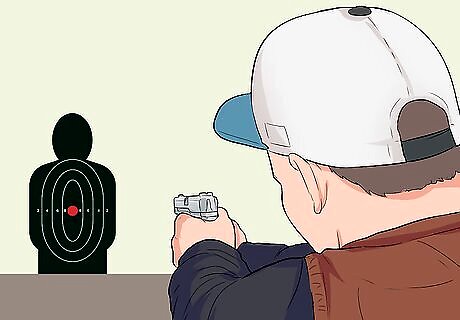
Familiarize yourself with the various skill requirements for conducting euthanasia. Training will be needed before you go ahead and use any equipment on an animal that requires euthanizing. Not only will you need to know how to handle the equipment properly with both your and others' safety in mind (this is of utmost priority), you will also need to know how to take care of it before and after use, from cleaning and loading to safe storage, among other details. Knowing where and how to aim is also very important, especially if you are handling a firearm. Safety training before using a firearm is highly recommended, and should also be required before even owning and operating a firearm. Countries vary in their laws with respect to training, permit-carry, and other details. Some have more strict laws than others. Please check with your local state or provincial department of justice (and your federal one) to see what the laws are for gun ownership are for your area. Also ask if they know of any potential times and places (or who puts them on) for firearm safety training. You may also require some training with handling a penetrating cap-bolt gun. Though there is not the kind of training as with fire-arms, it's highly recommended to read the manual that comes with it before use and familiarize yourself with how it handles, how to take it apart to clean and lubricate it, safe handling, and other useful information. Remember to treat a cap-bolt gun just like a regular handgun. It can be just as dangerous if mishandled. It is a tool to stun large animals with, but if improperly handled it can turn into a deadly weapon. Another skill requirement is target practice. In order to be successful at euthanizing an animal that is 10 times bigger than you and just as strong, you must be proficient at where to aim to make that kill-shot, and, most importantly, how to aim. If you are not confident with your aiming skills, then do not attempt to euthanize an animal yourself. Get someone that is more competent to do the job.
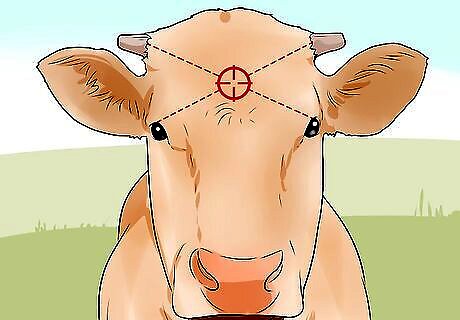
Familiarize yourself with the anatomical features or landmarks of a cow to be able to effectively and properly perform euthanasia. The target site is never between the eyes, but rather just above the eyes. An invisible X drawn from the outside corner of the eye to the base of the opposite horn or between the base of the ear and the poll. Aim at a 45º angle (or perpendicular to the skull) so that the bullet or cap-bolt penetrates the brain. This "angle of attack" and point of target is similar for adult cows, heifers, steers, and bulls. Calves younger than 6 months are very similar with target region.
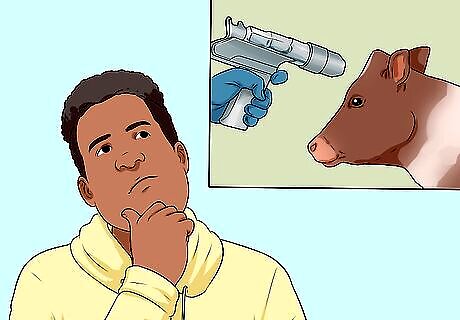
Formulate a plan of action when you may have to euthanize cattle. A plan includes the following criteria: Who is primarily responsible for conducting euthanasia; How soon after veterinary diagnosis or own judgement that an animal should be euthanized to reduce prolonged and unnecessary suffering; What are the various specific situations that euthanasia may be needed and how would the animal be dispatched as humanely and safely as possible; What method of choice is most practical according to a specific situation, personal preference, if a veterinarian is readily available/accessible, tools available, human safety, aesthetics (especially if you live or your pastures are right by a road with regular traffic), cost, skill level, etc.; What tools are easily accessible and ready to use when needed; What other tools or equipment can be use to keep yourself and others safe in case things don't go to plan; Where and how the carcass is to be disposed. This may include the considerations of what may possibly make this carcass suitable for consumption or not. Times when euthanized animals are not suitable for meat is when they are killed before the drug withdrawal period has ended, or they have a communicable disease that may pose a food safety hazard if the meat is consumed.
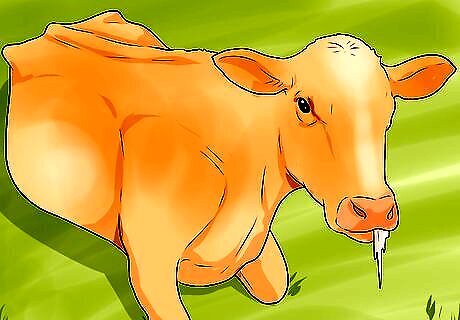
Understand the indications for when euthanasia needs to be administered. There are five primary indications where euthanasia is required : An animal's unlikeliness to recover from a disease; An animal's failure to respond to treatment or convalescent protocols; An animal has chronic, debilitating and/or severe pain and distress that cannot be relieved by treatment even in emergency medical situations An animal is unable to get to or consume feed and water; or An animal shows continual weight loss or emaciation despite continued efforts to correct the problem. Other indications include the following, which can be a combination of the primary indications mentioned above: An animal has a fractured leg, hip or spine which is not repairable and results in immobility and/or inability to stand; An animal experiencing emaciation and/or debilitation from disease or injury resulting in an animal being too weak to be transported or to get to or consume feed and water An animal experiences paralysis from traumatic injuries or disease resulting in immobility and inability to get to or consume feed and water; An animal has advanced eye disease (i.e., cancer-eye or lymphoma in cattle); An animal has disease condition where cost of treatment is prohibitive or impractical; An animal has a disease condition where no effective treatment is known (i.e., Johne’s Disease in ruminants, Foot and Mouth Disease, Mad Cow Disease, etc.), or the prognosis is poor, or the time to expected recovery is unusually prolonged and stressful for the animal; or An animal is suspected of having rabies or another disease where there is a significant threat to human health.

Decide if it would be more appropriate to treat the compromised animal or conduct euthanasia. You may also consider the other alternative of slaughter, if the following criteria influences your decision on any of these three options: Pain and distress of the animal (i.e., Is the animal in such pain and distress it is more crueller to try to save it and treat it, or if it can move on its own to be shipped to slaughter, or is the animal "non-ambulatory" [unable to move]); The likelihood of recovery from the inflicting illness or injury; The ability of the animal to get to feed and water; Drug withdrawal time (i.e., an animal euthanized before a 30-day withdrawal time has ended is not suitable for consumption); Economic considerations (i.e., practicality to treat based on time and money that may be required for treatment); Condemnation potential (i.e., drugs in system, stress and disease affecting meat quality, etc.) Diagnostic information (i.e., is animal going to recover with treatment, or is treatment going to be ineffective; type of disease or injury, etc.)
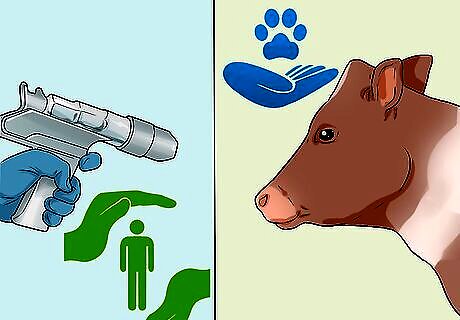
Analyze the considerations for selecting the best method of euthanasia. The following elements to help you decide which method is most appropriate. Human Safety. This must be your first consideration. Using a firearm, for example, is the most risky method of euthanasia. Animal Welfare. All methods of euthanasia must be effective in producing rapid death with no detectable distress or pain to the animal. The method selected must take into account both human safety and animal welfare that is appropriate for a specific situation. Restraint. Appropriate methods of restraint should be used with euthanasia procedures. Methods like captive-bolt will require excellent restraint of the animal. Availability and quality of halters, cattle chutes, gates or other forms of restraint make certain forms of euthanasia more suitable than others. Practicality. Appropriate euthanasia techniques must be practical to the situation and for you to use. Though you may be responsible for carrying out euthanasia you may not have quick or easy access to any tools needed for euthanasia. While this won't make euthanasia alone impractical, it may be necessary to call on a neighbour or veterinarian to do the process for you. Cost. Cost varies with euthanasia options. Certain methods require a large investment initially which may pay for itself over time if it gets used often. This is certainly true with using cap-bolt guns or firearms. Aesthetics. The appearance of a method being more humane over others may be an influencing factor in euthanasia method of choice. A lethal injection of barbiturate makes the death process appear more "peaceful" because of the lack of involuntary movements that are more associated with using a firearm or penetrating cap-bolt. To an individual inexperienced with bovine euthanasia, these involuntary movements may be easily misinterpreted as painful voluntary responses, which may be further misinterpreted as that particular method of euthanasia as being "inhumane" or "cruel." Thus when selecting a euthanasia method, the potential negative reactions by the animal and/or observer[s] should be considered. Diagnostics. If a sample needs to be collected for lab analysis, the selected method should not compromise that sample collection. This is especially true if a brain tissue sample needs to be sent in for BSE testing, for example. Carcass Disposal. One of the more critical considerations to make when selecting a euthanasia technique. Appropriate disposal of the carcass prevents scavenging and potential toxicity issues among wildlife. Carcasses must be handled and disposed of according to state/provincial and federal regulations. Options include rendering, composting, incineration and potentially landfills. Cattle euthanized with barbiturate overdose may not be accepted in rendering facilities because the drug tends to persist in the residual material following the rendering process. In some areas regulations require such animals to be incinerated or buried instead. Methods including gunshot or captive bolt may be more viable since they provide a more wider range of options for disposal.
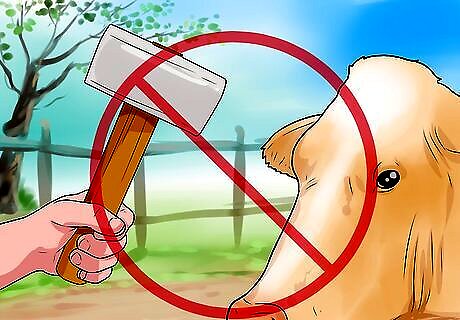
Understand which methods of euthanasia are not appropriate nor humane to be used on any classes of cattle. These are, via the 2013 AVMA Guidelines for Euthanasia of Animals: Manually-applied blunt-force trauma to the head of calves or mature cattle, such as by a large hammer; This technique is especially not recommended for young calves because their skulls are too hard for this method to be effective, as well as the method lacks consistency based on restraint and complications with positioning the calf for effective use of this method. A purpose-built, non-penetrating cap-bolt stunner is an acceptable method of euthanasia for calves, provided a secondary euthanasia technique is carried out immediately after to ensure a quick death. Injection of off-label chemical agents or substances not permitted for use as euthanasia agents (i.e., disinfectants, non-anaesthetic pharmaceutical agents); Sedation with an alpha-2 agonist such as xylazine, followed by potassium chloride, magnesium sulfate, or any other euthanasia method requiring the animal to be unconscious before its use; Injecting air into a vein; Electrocution with a 120 or 220 volt electrical cord; Drowning; Exsanguination of conscious animals.
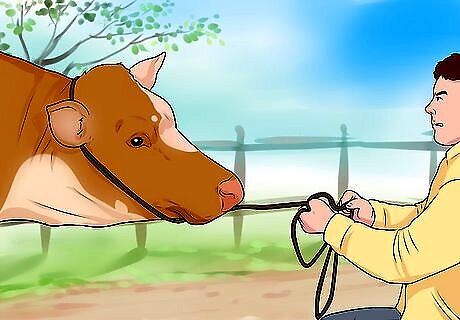
Move or handle cattle only if it's necessary. If you have to move or handle a cow prior to euthanasia, do so quietly and not more than what's necessary. You want to keep in mind that the animals be kept as stress-free and as calm as possible. Animals stressed prior to euthanasia are more prone to be dangerous and unpredictable. Keep the animal's and your safety in mind when choosing when and how to move an animal prior to euthanasia. Do not forcibly move or drag downer cattle prior to euthanasia. This will certainly cause unnecessary stress in the animal. Restraint--and in choosing what type--should also be done as safely and least stressful as possible. If you have unmanageable or aggressive animals to work with, consult with your veterinarian on using sedation to facilitate euthanasia.
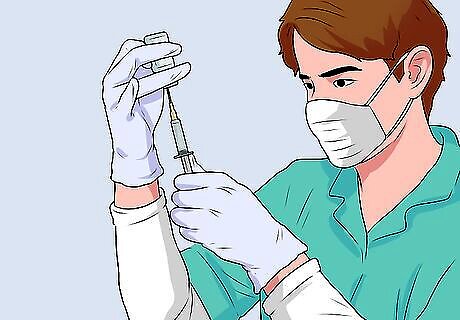
Properly carry out one of the recommended methods of choice to euthanize a cow. The methods below will guide you through what needs to be done to successfully and humanely euthanize a cow using barbiturate overdose, a cap-bolt gun, or a firearm. The first method, overdosing with barbiturate, should only done by a licensed veterinarian. This is primarily because all drugs used for euthanasia are not freely sold to any non-veterinary personnel since it is a powerful and potentially dangerous drug to administer. You would need proper veterinary training to be able to be qualified to administer this drug without needing a licensed vet to do so for you. The proceeding two methods can be carried out by non-veterinary personnel provided they have the proper training and skills to do so.
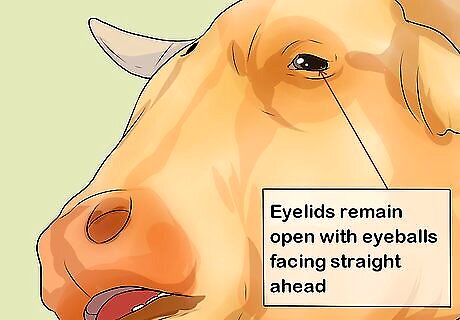
Confirm that the animal has been properly stunned or rendered unconscious. This is one of the most important steps because the first shot with a cap-bolt or firearm may not be enough to render the animal unconscious; soon followed by death. Be prepared to follow immediately with a second shot. The signs of unconsciousness shown by the animal are: Immediate collapse of the animal when the cap-bolt or firearm is discharged; No attempt by the animal to right itself following the stun or shot; Body muscles become rigid immediately after, followed by varying degrees of involuntary movement of the limbs; Normal rhythmic breathing stops; Eyelids remain open with eyeballs facing straight ahead, not looking around; and No vocalization is heard.
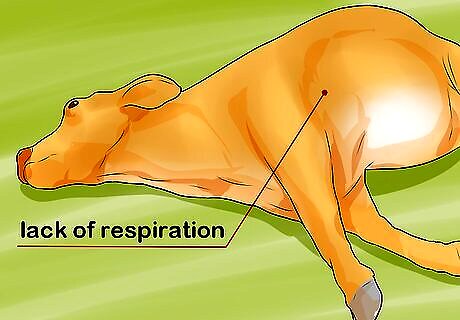
Confirm death using a combination of signs exhibited by the animal. Death does not occur immediately, but it is the result of respiratory and cardiac failure. This can take several minutes. Thus it is crucial that animals be rendered unconscious or insensible and remain insensible until death has occurred. Death is confirmed by all of the following: Lack of heartbeat; Lack of respiration (no sign of rise and fall of rib cage); Respiration rates can be erratic or absent in unconscious animals, so be cautious about using respiration as a interpretation for confirming death. Lack of corneal reflex (no response when the eyeball is touched); Normally conscious animals will blink when the eyeball is touched. Presence of rigor mortis. The above criteria will need to be observed for a period of at least 5 minutes after euthanasia. An alternative is to observe the animal for several hours; lack of movement in addition to the absence of a heartbeat, respiration and corneal reflex over an extended period of time further confirms that death has indeed occurred.
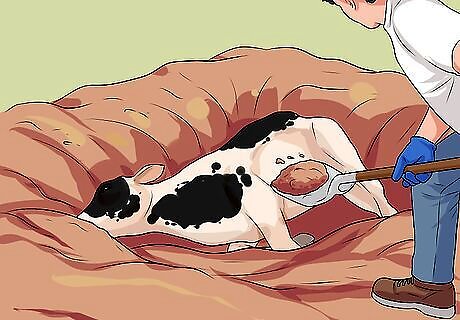
Dispose the animal's body properly in according to provincial/state and federal jurisdictions. Your local municipality may also have laws in place that determines how dead animals should be disposed properly by way of rendering, burial, composting, and incineration.
Overdosing with Barbiturate
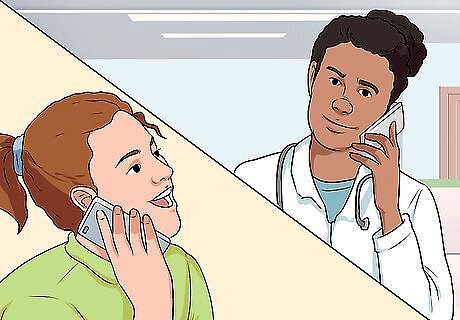
Contact the veterinarian so that they can perform this procedure for you. Only a certified, practicing veterinarian can perform this method legally because they are the only ones who have access to the drugs to do so. You cannot get sodium pentobarbital yourself anywhere without a license as a practicing veterinarian, because this drug is under federal jurisdiction for use and storage.
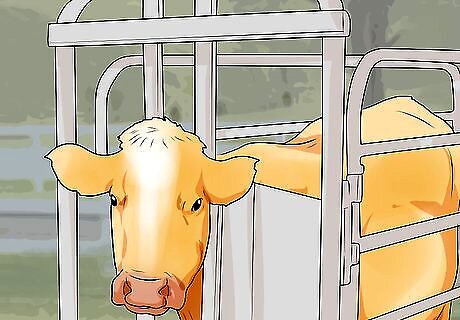
Restrain the animal per the directions from above. If the animal is ambulatory and unable to stand quietly while a needle is stuck into them, you will need to place them in a head-gate or squeeze chute (preferably one that has sides that open up for access to drag the deceased animal out afterwards) so that the vet can perform the task as safely as possible.
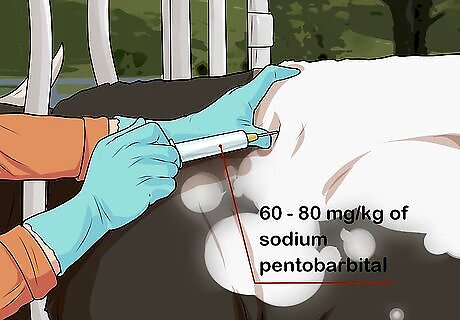
Allow the veterinarian to perform the procedure. Basically, the vet will be performing this method by giving the animal 60 to 80 mg/kg of sodium pentobarbital intravenously. This will be enough to produce rapid unconsciousness and anesthesia followed by respiratory depression, hypoxia (oxygen deprivation in body tissues), and cardiac arrest.
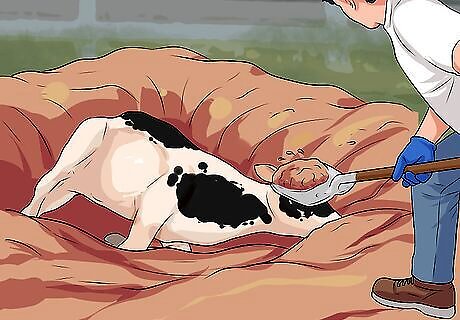
Dispose the carcass properly according to state/provincial or municipal jurisdictions. Animals overdosed with barbiturates cannot be used for human nor animal consumption because of the toxic barbiturates present in the tissues which can harm wildlife or stray animals. Carcasses must be properly buried or incinerated as necessary.
Using Penetrating Cap-Bolt Gun
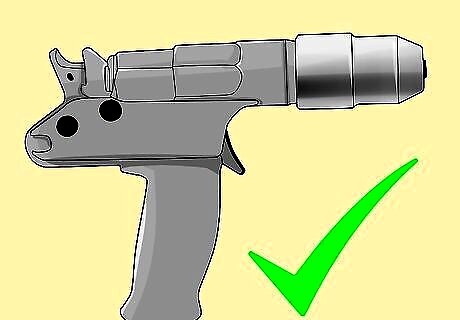
Prepare the cap-bolt gun. Make sure everything is functioning as it should, the gun has been cleaned well, and all pieces are together as they should be.

Prepare the secondary-euthanasia method choice for ready and immediate access. These include, as mentioned above, exsanguination, pithing, or a rapid IV injection of potassium chloride or magnesium sulfate. The latter is done by a veterinarian, and the other two require a very sharp knife, or a steel rod that fits into the hole made by the cap-bolt gun, respectively.
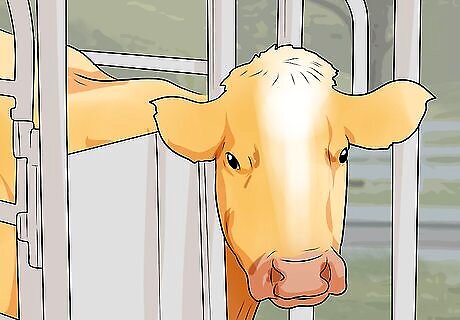
Restrain the animal as best as possible. Excellent restraint will be needed to perform this procedure, using a head-gate and squeeze chute, or a medina gate with a head-gate attached. The restraint is so that the stunned animal does not harm you or the person handling the cap-bolt gun, or itself beyond collapsing with the stun. Restraining by halter and lead is not enough, as this can pose significant risk to both you and the animal. If you are using a cap-bolt to euthanize, then avoid using a halter at all times. The squeeze or medina gate must be able to open to the outside to easily access the animal with a tractor or skid-steer. It is extremely difficult to extract a euthanized animal through the head-gate due to both weight and body shape.
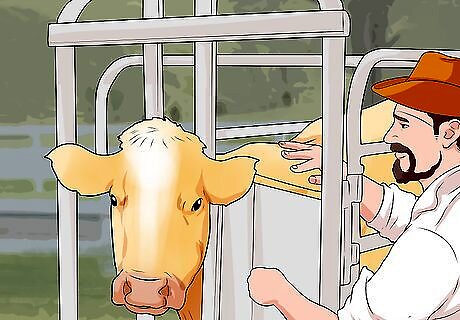
Let the animal settle down. An animal that enters the squeeze may be a bit afraid and panicked, so its best to wait until the animal has calmed down before proceeding with this method of euthanasia.
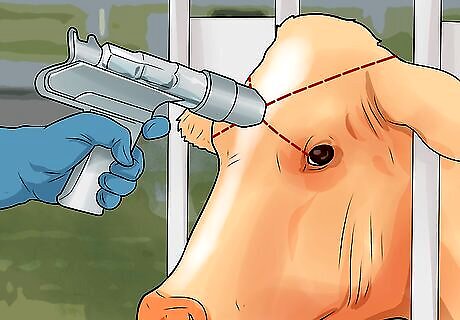
Place the muzzle of the cap-bolt gun at the meeting point (or just slightly above) between the invisible X formed on the forehead. The muzzle should be flush with the animal's forehead, and perpendicular with the angle of the animal's face itself. It may help you to draw that X on the animal's forehead with a Paintstik® or Producers Pride® livestock marker crayon to ensure you are targeting the right spot.
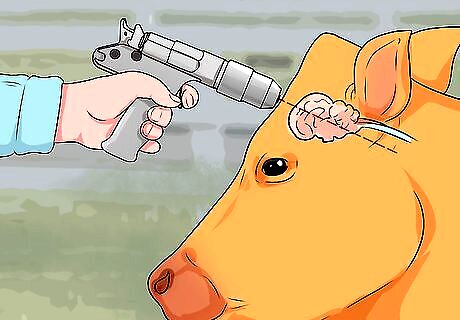
Squeeze the trigger. The firing mechanism in the cap-bolt will engage, sending the rod into the brain tissue of the animal through the skull. You will feel a sudden jolt, like firing a revolver, which means the gun has done its job. The rod will not stay in the brain tissue but come back into the gun via spring-action, and it's that rod that stuns the animal into unconsciousness. This step and the one before must be done in quick succession and without hesitation. If you keep the muzzle of the gun to the animal's head for just a little too long, the animal may swing its head up suddenly and cause you to miss the shot should you fire at the same time. Thus, if you're certain you're on the right spot, then immediately take the shot.
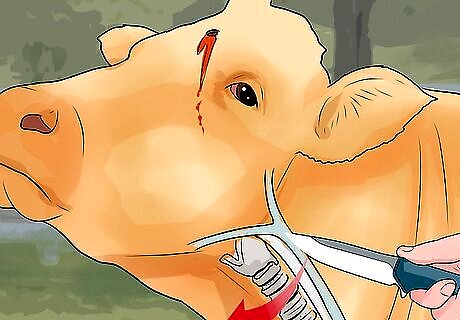
Follow immediately with the secondary euthanasia method of choice. This step is very important and must be performed within a few seconds--not minutes--to ensure death of the animal while it is still unconscious. The following secondary euthanasia methods and how to perform them are: Exsanguination: Using a very sharp knife, like a 6-inch hunting knife or boning knife, insert the blade fully behind the point of the jaw and draw downwards until blood is freely flowing. The carotid artery and jugular vein must be severed for this to work effectively. Another method of exsanguination or blood-letting is severing the brachial vasculature. Lift one of the forelimbs (one most easily accessible, as the animal will [or should] be laying on its side), and insert the knife deeply at the point of the elbow and cut the skin and vasculature until the limb can be laid back against the chest of the animal. Chest-sticking is done to severe the vessels that extend from the top of the heart, like the vena cava and aorta. It is probably the most effective method of exsanguination because all blood flow to the head is stopped once these vessels are cut. A long blade (~6 to 8 inches, as mentioned) needs to be used; Insert fully into the chest in the mid-line where the brisket joins the ventral neck. Use a sideways slicing action in one direction and then the other to ensures that the vessels are severed. A third method is transecting the terminal aorta via the rectum so that blood pools in the abdominal cavity. This should only be done by a trained individual, like a veterinarian. Pithing: Insert a pithing rod or similar tool into and through the entry site, and manipulate the rod deep into the head of the animal to destroy both brain stem and spinal cord tissue attached to the brain to ensure death of the animal. Lethal IV Injection: A rapid injection of a saturated solution of either potassium chloride (KCl) or magnesium sulfate into the blood vessel will induce cardiac arrest. For most mature cows, an injection of 250 mL of KCl is appropriate, but the exact dosage for any animal may vary due to size of the animal. Solution must be given until death is confirmed. Magnesium sulfate is delivered similar to KCl, but is approved for use only in anaesthetized animals, and results in much slower death. Cattle must be unconscious or anaesthetized before this particular method can be used. It's also recommended to have a veterinarian perform this secondary euthanasia procedure.
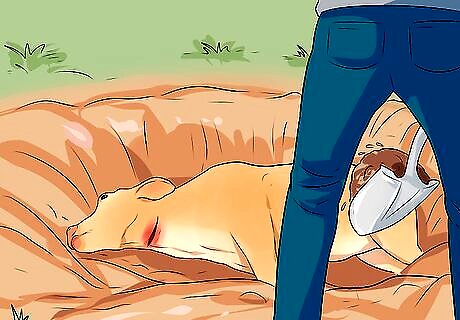
Dispose of the carcass properly. Depending on the secondary euthanasia method of choice and the state of the carcass, disposal is more flexible than when using barbiturates. If an animal does not have any drug residues in its system (from either euthanasia or prior attempted treatments), there is a possibility it can be butchered for meat. Check with your vet to be sure.
Dispatching with Gunshot

Select the right gun with the right bullets for the job. Current AVMA recommendations suggest that a .22 caliber handgun or right loaded with a solid-point bullet is sufficient for calves, but is not be recommended for use for more mature, larger stock. You are best to go with a handgun or rifle that have muzzle energies above 300 ft/lb. It's important to use solid-point bullets as well with these higher-caliber guns. Bulls will need heavier-powered firearms to be euthanized. The best are those that are capable of 1000 ft per lb of muzzle velocity to be able to penetrate the very thick skull of a bull. Some countries, like in Canada, dictate that the .22 rifle is not humane for euthanizing any cattle, but rather firearms with muzzle energy of at least 300 ft/lb are ideal for calves under 400 pounds, and firearms with energies at 1000 ft/lb or more are recommended for mature livestock from cows to bulls. Shotguns are an excellent alternative to handguns or rifles, but they carry a little greater margin of risk, especially if used at greater distances than the recommended 1 to 2 yards (1 to 2 meters) from the intended target. Use of the 12, 16, and 20-gauge shotguns are ideal for mature cows, bulls, elk, and horses loaded with slugs or No. 2-, 4-, or 6-size birdshot. The .410 or .28 gauge shotguns should not be used on larger animals because of the lower muzzle velocity.
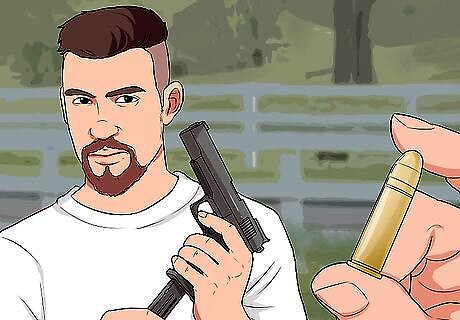
Prepare the gun. Make sure it's loaded with the proper type of bullets (like solid points, never hollow nor soft-points) or slugs if using a shotgun. You may need more than one bullet or slug to do the job, just in case.

Assess the animal to be euthanized, and the best target location. Restraint is not needed when euthanizing via gunshot, and an animal can be on its feet and mobile, or are down or debilitated to be effectively killed. The latter two are less difficult with placement of the bullet. However, when the animal is on its feet, on the move and posing to be a dangerous threat, the recommended standard of shooting at the forehead may be much more of a challenge. A downed or compromised animal is easier to shoot at the head. This is because the angle of the shot is very important for the bullet to not only penetrate the brain, but also into the brainstem. It is very difficult to aim perpendicular to the head when the animal is standing up or moving away, unless you are very very tall or the animals are very short and small. You can also shoot them at a closer distance, at the recommended 1 to 3 feet from the intended target. Animals on their feet generally won't allow you to get at arm's-length from them, and you wouldn't want to especially with dangerous stock. These animals will need to be shot from a distance, aiming for the lower chest just above the elbow (or behind if the animal is moving away at an angle you can still see the target zone), the head, or neck. Shooting a cow or bull like this would be no different from hunting and shooting big game, because they all have the same anatomical features where bullet placement is ideal for a one-shot kill.
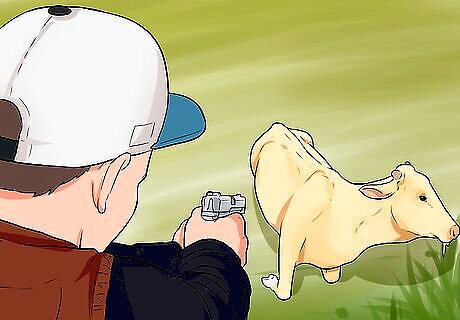
Aim at the targeted location and make the shot. Be prepared to make a second shot immediately after the first if the first shot is not successful. Aim for the right location to make the second shot count this time. As mentioned, the closest you should be to a downer or debilitated animal is one to three feet away.

Approach the downed animal with caution and assess it. Be careful with animals that were on their feet and mobile as they may be down and thrashing around violently, which is to be expected with euthanizing via gunshot. Using the steps above, assess the animal for signs of unconsciousness then death, which will come very soon after the shot has been made. There is no need to follow with a secondary euthanasia technique following a gunshot, unless the animal is going to be slaughtered for meat. Then exsanguination will need to be used to save the meats being used for consumption.
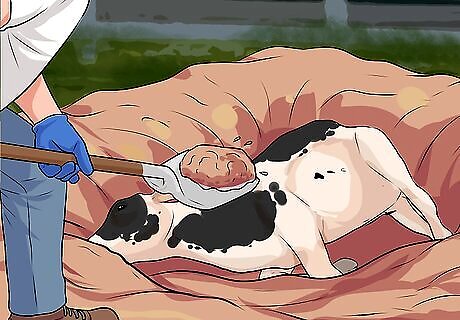
Dispose of the carcass appropriately. As with the cap-bolt method, disposal of cattle euthanized with gunshot is more flexible. They can be rendered, buried, burned, or used for consumption. Euthanizing a sick animal with drugs still in its system may have some restrictions, especially with concerns of drug residue. This type of animal should neither be consumed nor rendered for the sake of food safety laws and regulations.




















Comments
0 comment